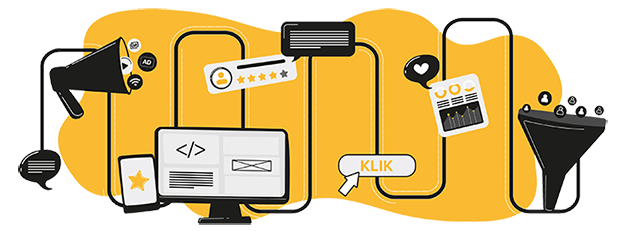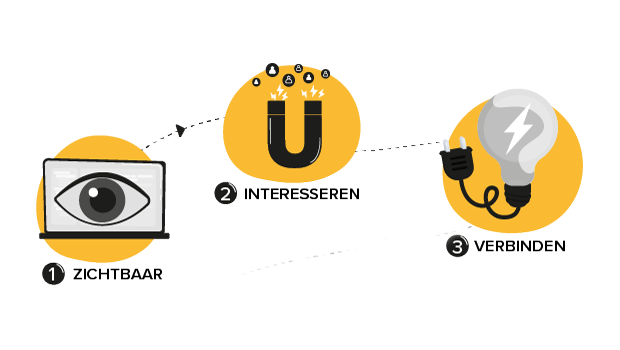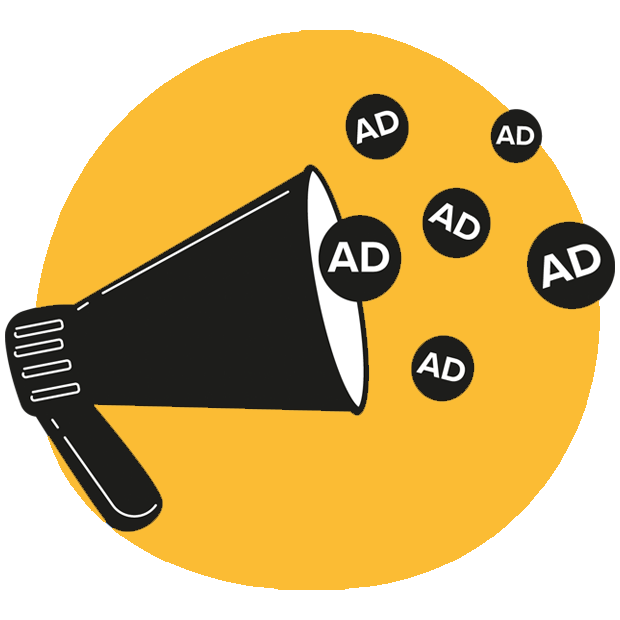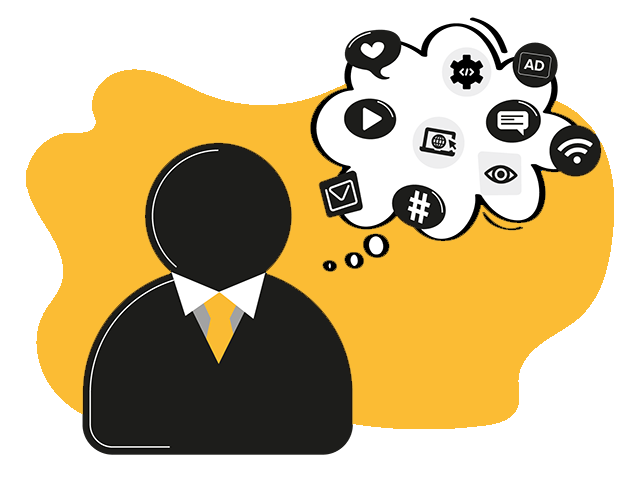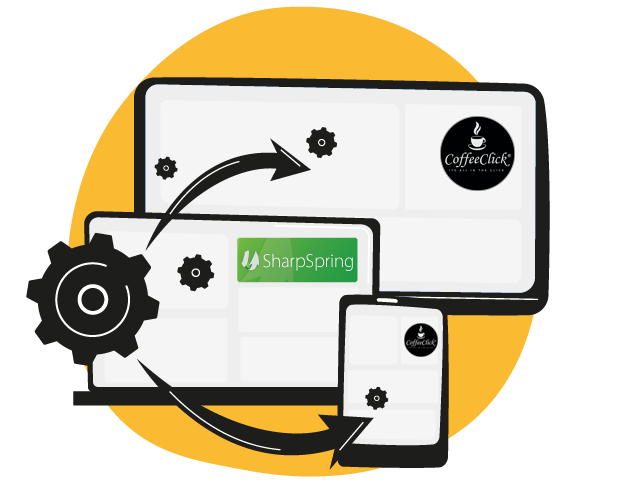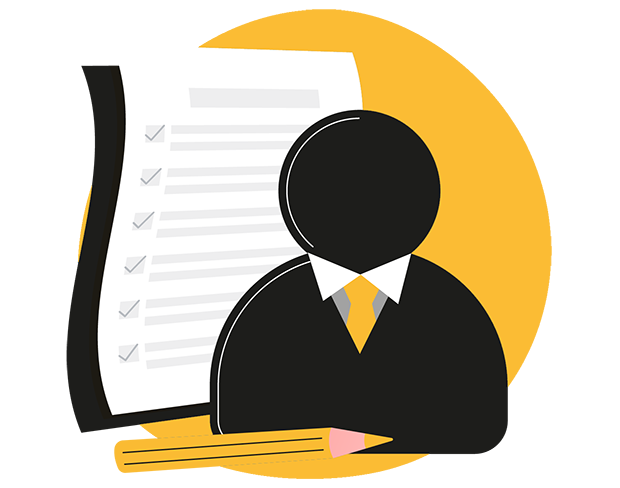The icing on the cake. The Final Chapter. The glue between the schurq. puzzle. This blog is mostly, how appropriate in the last blog, about looking back. Reiterating all the information we have given. Only the important parts, of course, so that your memory is refreshed. Or maybe you haven't read any of our blogs yet, then you can use this last one as a summary. Above all, take the time to read how the different parts work on their own, and how they fit into the Machine. For each part, we also link back to the full blog on that topic so that when interested, you can easily go back. So please take your time. We wish you much reading pleasure.
The beginning of your strategy. The target audience. Simply put, the people you want to reach with your product or service. But what makes the people within this target group "suitable" for the product or service you offer? Have you established specific criteria by which you determine who belongs to the target group. Or have you based this on assumptions?
We ask this question for the following reason. When we begin a relationship with a new or potential client, we always begin with a strategy session. Previously, one of the first questions we asked in this conversation was the question; "'who is the target audience'". But experience has taught us, that the answer to this question was often based on assumptions rather than research and testing.
That's why we're doing it differently now. Instead of asking this question, we are going to investigate. Together with the customer, of course. And indirectly also with the end customer. After all, as an entrepreneur and provider of a product or service, you already possess a lot of information. After all, you already have customers, and these customers bought your product or service for a reason. And precisely this reason is what we can use to reach new customers who might be interested in your product or service.
Before the strategy session, therefore, we provide you with some homework. A questionnaire that you then submit to (part of) your customers. With these questions we not only find out why someone chose your product or service, but also precisely why this person entered the market in the first place. And precisely with this information about the target audience and their pain points, we can determine strategy! How these reasons can differ from each other and why that is important, we are of course going to elaborate on that. But in the next section; the buyer's journey.
Key take-away from this piece: the reason someone chooses to buy your product or service is not always the reason they interact with your product or service in the first place.
Why is this so important? Because in order to reach new customers for your brand, we need to deliver a message. A message that appeals to the right target group and preferably responds to one or more pain points of this target group. As you may know, we divide the customer journey into different phases. In the first phase you want to be visible, in the second phase you want to interest and then on to the third phase; connecting. We'll come back to these phases later, but what is especially important in this piece is that we need a different approach in each of these phases to achieve the goal within that particular phase.
Back for a moment to what this has to do with the take-away. So we already said that in order to appeal to the phase a person is in, you need to use the right message to trigger in this phase. But to tailor this message to the phase, you will need to know what pain points and or needs of the target audience are important in this phase. Because if you address a prospect with a message that yes... does not appeal, you will lose him or her. And that, of course, is not the intention!
In the full blog on this buyer's journey, we illustrate this with an example. Click for the example here.
Do you have an understanding of the customer journey and know which content and message you can best address individuals with at each stage? Then you can also guess which piece of content they would leave their data for. We call that piece of content the lead magnet.
The lead magnet. As we just mentioned, a piece of content that is valuable enough for a person to leave their contact information. What's important to remember about this lead magnet. It has to be a piece of content that is valuable to your specific target audience. Therefore, go back to the audience research. What were the pain points and or needs among the target audience that caused them to come into the market for your product or service. These are the pain points and or needs that you will need to address with the lead magnet.
In the form, you have the opportunity to ask more about the lead's specific situation. And the more attractive your offer? The more data individuals are willing to leave behind! This data then forms the basis for the personalized, automated email follow-up, but more on that later! What is important to mention regarding the lead magnet is that it does not always happen that a lead magnet is right the first time. Therefore, you will test with different types of lead magnets. And even more testing. Just until you find just the right approach and message. The one that triggers your target audience enough.
Examples of lead magnets can be found here!
Building funnels plays a big role in our schurq. method. Why? Because we believe that individuals need to be taken by the hand. Need to be guided through the customer journey. And the way to do that, in our humble opinion, is to divide this journey into different phases. With a different message at each stage. A different approach, perhaps even through a different platform.
So we build comprehensive funnels within each ad platform, in this case Facebook, Instagram, LinkedIn and YouTube. But! Where it gets really interesting is when we merge this into an omnichannel ads funnel. Through every platform. So that your target audience encounters you everywhere. At exactly the right time, with exactly the right message. This is how you show your target group the way. Towards the next touchpoint in the customer journey.
Of course, we have articulated this at length on our website. Too long for this blog, therefore no less interesting to read. If you are more interested in this part of the Machine, then we recommend that you go through these pages to see if this could be interesting for your organization.
How this fits into the Machine is simple. Because we use this way of advertising, we also learn from the target audience. What platform are they most active on? Through which channel are they most open to our message? And by advertising in multiple channels at the same time, you can also test with multiple messages, lead magnets and maybe even lead ads vs. landing pages. This way you test your approach through and through. You're never too old to learn! Not even as an organization.
The ultimate goal of this funnel? Getting individuals to convert, of course. The moment they leave their data is called the opt-in. So this should be the next part of the Machine. But! schurq. wouldn't be schurq. if we did this differently. In fact, we add an additional component here.
MQV? Maybe you don't know this term. Logical. After all, we created it ourselves. Simply, we label your website visitors as Marketing Qualified Visitors (MQV) when companies leave no data behind, but have visited your website and have shown interesting behavior on this website.
Through recognition of these visitors based on IP addresses, in combination with a link with the Chamber of Commerce (CoC), we can map out the company data associated with them. This way, your unknown visitor suddenly gets a personality.
What's the big advantage of this, other than giving you insight into what types of businesses are visiting your Web site? We'll tell you. We mentioned behavior briefly just now. But this behavior can be used as a trigger for certain, automated actions. For example, you can have an automatic notification sent to sales when a person visits 3 or more pages that you have marked as interesting. That way they know which company is showing a certain level of interest. Enough information to pick up the phone for sales?
You can also use website visitor behavior to adjust the conversion path on your website. After all, you know which pages are viewed a lot, and also which are not. Then use this data to create the ideal conversion path on your website. Everything to guide the leads towards that moment when they do leave their personal data on the website! Your MQV then becomes a Marketing Qualified Lead, or MQL.
Creating the ideal conversion path. Sounds simple. Is it often not without the right advice and the right kind of data analysis. The goal of conversion optimization is to increase the percentage of visitors who take a desired action on a web page.
Why is continuing to optimize your Web site important? There is a danger to having a website. Overdue maintenance. To stay ahead of your competition as an organization, you will need to keep maintaining the website. You set goals for your organization, staff and maybe even yourself.
In addition, the organization, your staff and the market are also constantly developing themselves. So, to achieve these goals, the website must also be maintained. To be developed. After all, it is a reflection of your company to the, often largely unknown, outside world. And surely it would be a shame if this reflection becomes ever so slightly further removed from reality, to the point that it no longer matches how you see the organization when you know it.
Beyond the fact that the website must be optimized to provide both customers and potential customers with relevant information, more is possible. Through tooling on the one hand and a Customer Data Platform on the other, it is possible to personalize your website. To build 360 degree customer profiles where you can use data and behavior of visitors on your website to apply personalizations. Because as we mentioned before (several times), you have a target audience. Who goes through multiple phases. In which a different message could appeal to each phase. So why not do this on the website as well?
If you want more information about this in details, you can of course read back through this page. In the schurq. Machine this way of conversion optimization is no longer really a stand-alone thing, but even this part of the strategy is divided into a funnel, where the message is tailored to the person level.
Is your website optimized? Ready to capture the leads from the campaigns, so to speak, and provide them with the right, relevant information? Then let's move on to the next part.
A system that allows streamlining and automating your marketing communications. That enables and also facilitates communication with both prospects and customers. This process starts from the moment of opt-in. A person has left his or her data on the website or through a campaign. So from this moment, you have permission to approach this person. In a sense, this person has even asked for this!
But at this point, this person's level of interest is not 100% clear. Someone may be interested in your lead magnet simply because they are looking for information about your product or service. So at this point, it's a waste to have your account managers contact them. That's where Marketing Automation can play a big role.
Back to the moment of opt-in for a moment. In the contact form where they leave their details, you have the option to segment people right away. Based on these segments, you can then further personalize your automated communication workflows.
Ask for the current situation, and then provide individuals with itemized information on how your product or service, fits this. The behavior of leads within your system helps enrich the lead's profile. This additional information, of course, is never wrong. You can use this information to further personalize the automated communication, and your account managers can use this information when making personal contact.
For example, once a person has opened and perhaps even answered several emails from you, the system sends an automatic notification to the appropriate account manager that this lead is "warm" enough to contact you. This way, this contact is never too early, and certainly not too late. From the moment the lead's behavior can be a trigger for an automated sales action, it moves into Sales Automation.
Marketing and Sales Automation, when properly set up, are the perfect team. They complement each other when and where the moment is right. This is the final part of our schurq. Machine. Therefore no less important. After all, this is the moment when your leads go from Sales Qualified (SQL) to customer. All the work we've done so far has been a run-up to this moment. How it ends up, that is partly determined by how your Sales Automation is set up.
Simply put, Sales Automation is the automation of sales tasks, based on behaviors and triggers. The beauty of automating these sales tasks is that your account managers only have to come into the picture to personally contact leads when the time is just right. When is the time right? When you're sure their interest has been piqued. This allows your account managers to spend their time efficiently!
Marketing Automation has ensured that your lead has been sent relevant information based on his or her specific situation. How this lead subsequently reacts to that, is reflected in this person's lead score. Certain actions, such as filling out an extra form or changing a certain field, can trigger one or more automated sales tasks. Think of this as sending a notification to the relevant account manager, after which he personally takes over and the SQL hopefully becomes a customer. This is in the hands of the account manager; from here on, the schurq. Machine has done its job. Until, of course, this customer comes back into the Marketing Automation system for further nurturing. Then the story starts, in part, all over again! :)
The Machine seems large. That's why it's important as an organization to have a central place where everything comes together. Where you have insight into the results so you can steer accordingly. That's why we added the dashboarding piece to our Machine. A complete dashboard containing all your leads, the status they are in and the estimated value. Per account manager. So that you can, at management level, report and steer on these results. How convenient is that?
The end of our story. The entire blog series to an end. And so put together, it has become, as it were, a blueprint of our way of working. A mini manifesto. Let the entire blog series, and this one in particular, be a guide. One that takes you by the hand and tells you about all that is possible.
And see the parts of our Machine as complementary. Where all the individual parts complement each other, complete each other. And then when all the parts come together... Then that ultimate synergistic effect is created. What you as an organization have been looking for all along, consciously or unconsciously. We are ready to start your story, are you?
